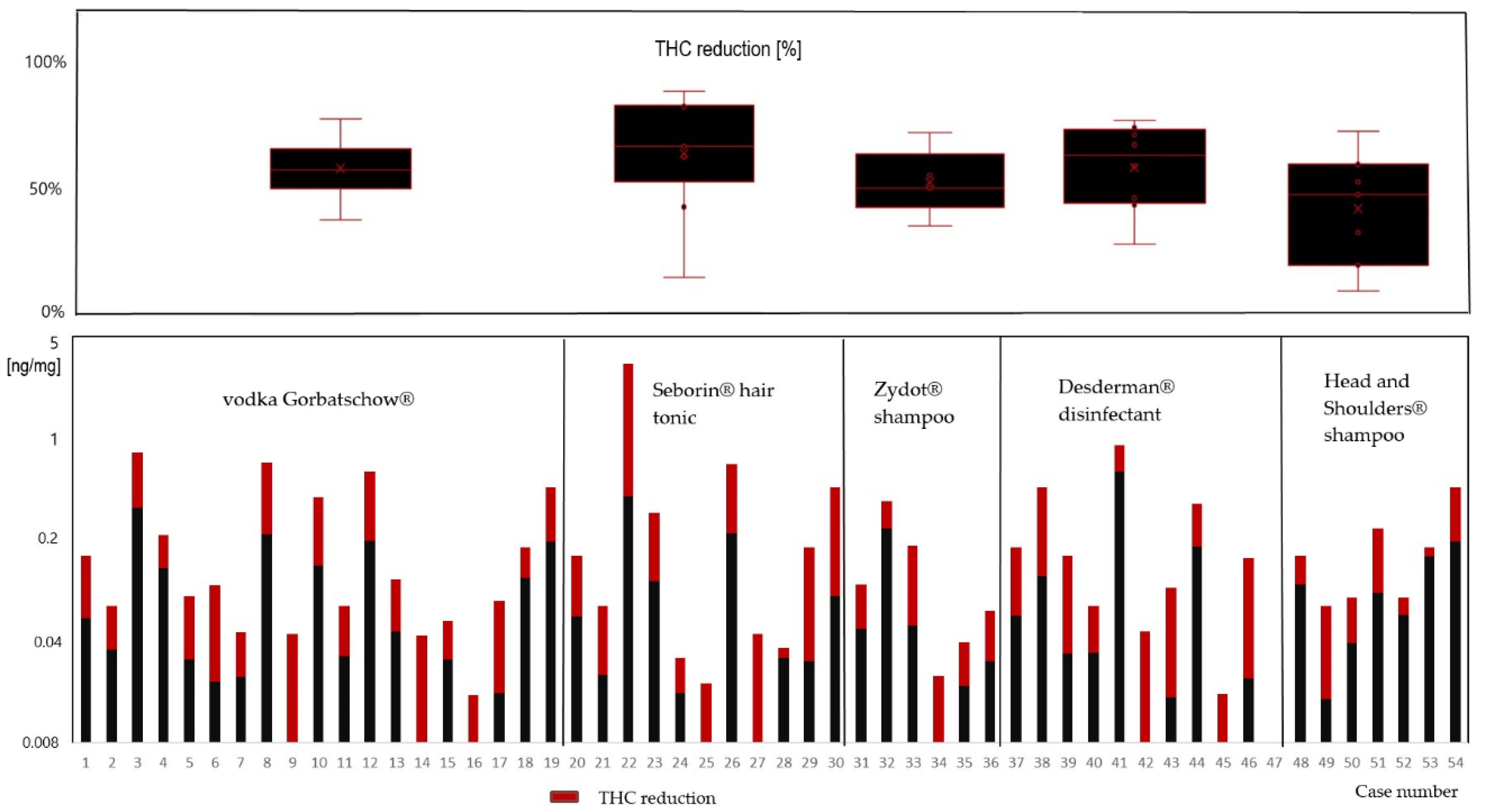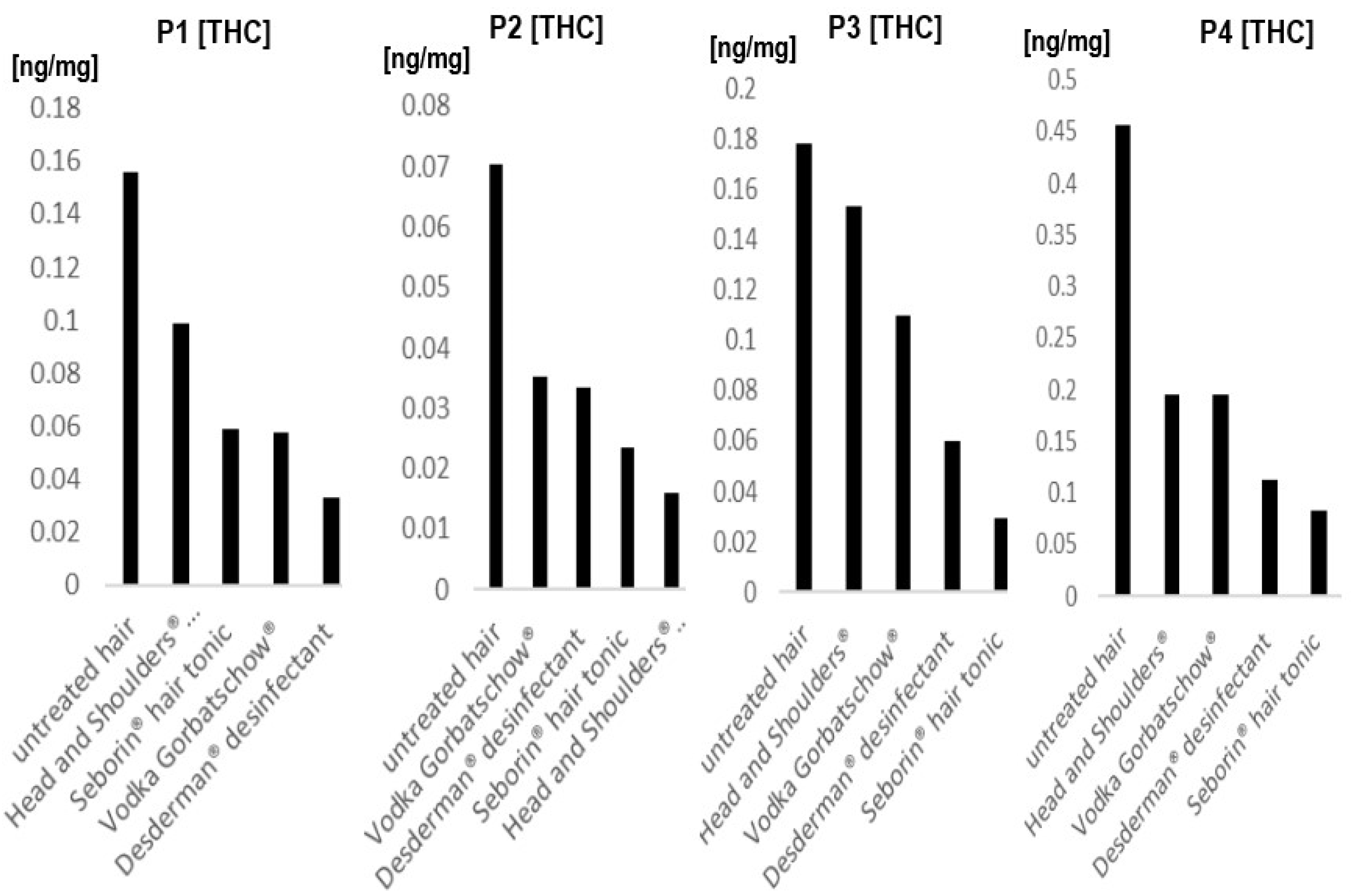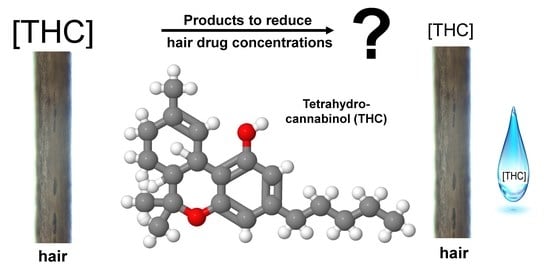Manipulation of THC Hair Concentrations by Commercially Available Products
Abstract
:1. Introduction
2. Materials and Methods
2.1. Chemicals
2.2. Hair Samples
2.3. Cosmetic Treatment
2.4. Sample Preparation
2.5. LC-MS/MS Analysis
2.5.1. Analytical Method
2.5.2. Data Validation
2.6. Statistical Analysis
2.7. Ethics
3. Results
Chemical Toxicological Hair Analysis
4. Discussion
5. Conclusions
Author Contributions
Funding
Institutional Review Board Statement
Informed Consent Statement
Data Availability Statement
Conflicts of Interest
References
- Schubert, W.; Dittmann, V.; Brenner-Hartmann, J. Beurteilungskriterien: Urteilsbildung in der Medizinisch-Psychologischen Fahreignungsdiagnostik, 3rd ed.; Kirschbaum Verlag: Bonn, Germany, 2013. [Google Scholar]
- Cooper, G.A.; Kronstrand, R.; Kintz, P. Society of Hair Testing guidelines for drug testing in hair. Forensic Sci. Int. 2012, 218, 20–24. [Google Scholar] [CrossRef] [PubMed]
- Usman, M.; Naseer, A.; Baig, Y.; Jamshaid, T.; Shahwar, M.; Khurshuid, S. Forensic toxicological analysis of hair: A review. Egypt. J. Forensic Sci. 2019, 9, 17. [Google Scholar] [CrossRef]
- Ferreira, C.; Paulino, C.; Quintas, A. Extraction procedures for hair forensic toxicological analysis: A mini-review. Chem. Res. Toxicol. 2019, 32, 2367–2381. [Google Scholar] [CrossRef] [PubMed]
- Auwärter, V.; Wohlfarth, A.; Traber, J.; Thieme, D.; Weinmann, W. Hair analysis for Δ9-tetrahydrocannabinolic acid A—New insights into the mechanism of drug incorporation of cannabinoids into hair. Forensic Sci. Int. 2010, 196, 10–13. [Google Scholar] [CrossRef] [PubMed]
- Dyer, J.M.; Bell, F.; Koehn, H.; Vernon, J.A.; Cornellison, C.D.; Clerens, S.; Harland, D.P. Redox proteomic evaluation of bleaching and alkali damage in human hair. Int. J. Cosmet. Sci. 2013, 35, 555–561. [Google Scholar] [CrossRef] [PubMed]
- Kerekes, I.; Yegles, M. Coloring, Bleaching, and Perming. Ther. Drug Monit. 2013, 35, 527–529. [Google Scholar] [CrossRef] [PubMed]
- Jurado, C.; Kintz, P.; Menéndez, M.; Repetto, M. Influence of the cosmetic treatment of hair on drug testing. Int. J. Leg. Med. 1997, 110, 159–163. [Google Scholar] [CrossRef] [PubMed]
- Van Elsué, N.; Yegles, M. Influence of cosmetic hair treatments on cannabinoids in hair: Bleaching, perming and permanent coloring. Forensic Sci. Int. 2019, 297, 270–276. [Google Scholar] [CrossRef] [PubMed]
- Peters, F.T.; Hartung, M.; Herbold, M.; Schmitt, G. Appendix B: To the GTFCh Guidelines for quality assurance in forensic-toxicological analyses Requirements for the validation of analytical methods. Requirements for the validation of analytical methods Guideline of the German Society of Toxicology and Forensic Chemistry: Validation of methods. Toxichem Krimtech 2009, 76, 185–208. [Google Scholar]


| Case Number | Product | Untreated Sample [ng/mg] | Treated Sample [ng/mg] * | Reduction [%] | Average Reduction [%] |
|---|---|---|---|---|---|
| 1 | vodka Gorbatschow 1 | 0.156 | 0.0576 | 63 | |
| 2 | vodka Gorbatschow 2 | 0.0704 | 0.0351 | 50 | |
| 3 | vodka Gorbatschow 3 | 0.798 | 0.332 | 58 | |
| 4 | vodka Gorbatschow 4 | 0.216 | 0.128 | 41 | |
| 5 | vodka Gorbatschow 5 | 0.0816 | 0.0302 | 63 | |
| 6 | vodka Gorbatschow 6 | 0.0973 | 0.0211 | 78 | |
| 7 | vodka Gorbatschow 7 | 0.0461 | 0.0228 | 51 | |
| 8 | vodka Gorbatschow 8 | 0.680 | 0.219 | 68 | |
| 9 | vodka Gorbatschow 9 | 0.0453 | <LoD | NA | 58 |
| 10 | vodka Gorbatschow 10 | 0.395 | 0.133 | 66 | |
| 11 | vodka Gorbatschow 11 | 0.0701 | 0.0317 | 55 | |
| 12 | vodka Gorbatschow 12 | 0.585 | 0.196 | 66 | |
| 13 | vodka Gorbatschow 13 | 0.106 | 0.0469 | 56 | |
| 14 | vodka Gorbatschow 14 | 0.0441 | <LoD | NA | |
| 15 | vodka Gorbatschow 15 | 0.0558 | 0.0299 | 46 | |
| 16 | vodka Gorbatschow 16 | 0.0171 | <LoD | NA | |
| 17 | vodka Gorbatschow 17 | 0.0762 | <LoD, approx. 0.0175 | 77 | |
| 18 | vodka Gorbatschow 18 | 0.178 | 0.110 | 38 | |
| 19 | vodka Gorbatschow 19 | 0.457 | 0.195 | 57 | |
| 20 | Seborin hair tonic 1 | 0.156 | 0.0592 | 62 | |
| 21 | Seborin hair tonic 2 | 0.0704 | 0.0236 | 66 | |
| 22 | Seborin hair tonic 3 | 3.27 | 0.399 | 88 | |
| 23 | Seborin hair tonic 4 | 0.308 | 0.104 | 66 | |
| 24 | Seborin hair tonic 5 | 0.0307 | <LoD, approx. 0.0177 | 42 | |
| 25 | Seborin hair tonic 6 | 0.0207 | <LoD | NA | 63 |
| 26 | Seborin hair tonic 7 | 0.659 | 0.2220 | 66 | |
| 27 | Seborin hair tonic 8 | 0.0451 | <LoD | NA | |
| 28 | Seborin hair tonic 9 | 0.0362 | 0.0310 | 14 | |
| 29 | Seborin hair tonic 10 | 0.178 | 0.0294 | 83 | |
| 30 | Seborin hair tonic 11 | 0.457 | 0.0820 | 82 | |
| 31 | Zydot 1 | 0.0987 | 0.0489 | 50 | |
| 32 | Zydot 2 | 0.370 | 0.239 | 35 | |
| 33 | Zydot 3 | 0.182 | 0.0512 | 72 | 52 |
| 34 | Zydot 4 | 0.0230 | <LoD, | NA | |
| 35 | Zydot 5 | 0.0394 | <LoD, approx. 0.0198 | 50 | |
| 36 | Zydot 6 | 0.0650 | 0.0293 | 55 | |
| 37 | Desderman disinfectant 1 | 0.178 | 0.0598 | 66 | |
| 38 | Desderman disinfectant 2 | 0.457 | 0.112 | 75 | |
| 39 | Desderman disinfectant 3 | 0.156 | 0.0329 | 79 | |
| 40 | Desderman disinfectant 4 | 0.0704 | 0.0333 | 53 | |
| 41 | Desderman disinfectant 5 | 0.892 | 0.590 | 34 | |
| 42 | Desderman disinfectant 6 | 0.0468 | <LoD | NA | 65 |
| 43 | Desderman disinfectant 7 | 0.0929 | <LoD, approx. 0.0164 | 82 | |
| 44 | Desderman disinfectant 8 | 0.356 | 0.179 | 50 | |
| 45 | Desderman disinfectant 9 | 0.0174 | <LoD | NA | |
| 46 | Desderman disinfectant 10 | 0.150 | 0.0223 | 85 | |
| 47 | Desderman disinfectant 11 | <LoD | <LoD | NA | |
| 48 | Head & Shoulders 1 | 0.156 | 0.0985 | 37 | |
| 49 | Head & Shoulders 2 | 0.0704 | <LoD, approx. 0.016 | 77 | |
| 50 | Head & Shoulders 3 | 0.080 | 0.0388 | 52 | |
| 51 | Head & Shoulders 4 | 0.240 | 0.0869 | 64 | 52 |
| 52 | Head & Shoulders 5 | 0.0800 | 0.0611 | 24 | |
| 53 | Head & Shoulders 6 | 0.178 | 0.153 | 14 | |
| 54 | Head & Shoulders 7 | 0.457 | 0.195 | 57 |
Publisher’s Note: MDPI stays neutral with regard to jurisdictional claims in published maps and institutional affiliations. |
© 2022 by the authors. Licensee MDPI, Basel, Switzerland. This article is an open access article distributed under the terms and conditions of the Creative Commons Attribution (CC BY) license (https://creativecommons.org/licenses/by/4.0/).
Share and Cite
Bertges, M.; Ketikidou, A.; Weiskirchen, R.; van Helden, J.; Boehnke, R.; Hess, C. Manipulation of THC Hair Concentrations by Commercially Available Products. Metabolites 2022, 12, 900. https://doi.org/10.3390/metabo12100900
Bertges M, Ketikidou A, Weiskirchen R, van Helden J, Boehnke R, Hess C. Manipulation of THC Hair Concentrations by Commercially Available Products. Metabolites. 2022; 12(10):900. https://doi.org/10.3390/metabo12100900
Chicago/Turabian StyleBertges, Markus, Alexandra Ketikidou, Ralf Weiskirchen, Josef van Helden, Rudolf Boehnke, and Cornelius Hess. 2022. "Manipulation of THC Hair Concentrations by Commercially Available Products" Metabolites 12, no. 10: 900. https://doi.org/10.3390/metabo12100900
APA StyleBertges, M., Ketikidou, A., Weiskirchen, R., van Helden, J., Boehnke, R., & Hess, C. (2022). Manipulation of THC Hair Concentrations by Commercially Available Products. Metabolites, 12(10), 900. https://doi.org/10.3390/metabo12100900









